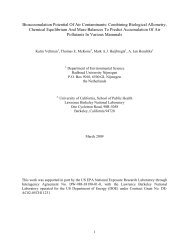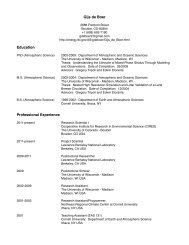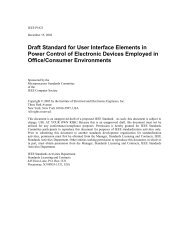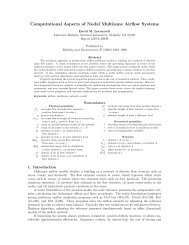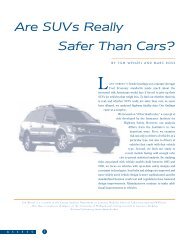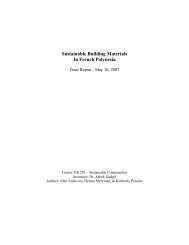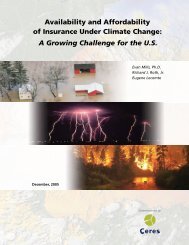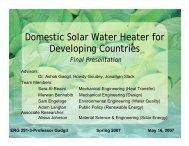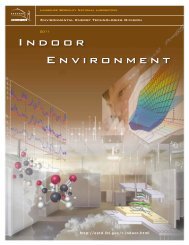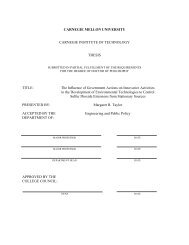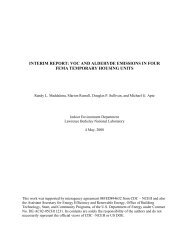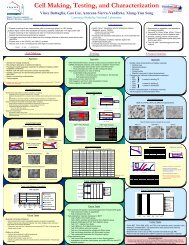Experimental and LES Study of Low Swirl Flame
Experimental and LES Study of Low Swirl Flame
Experimental and LES Study of Low Swirl Flame
Create successful ePaper yourself
Turn your PDF publications into a flip-book with our unique Google optimized e-Paper software.
11th Premixed Turbulent <strong>Flame</strong> Workshop, Montreal, August 9-10, 2008<br />
<strong>LES</strong> <strong>and</strong> laser diagnostics <strong>of</strong> a low<br />
swirl methane/air flame<br />
K. Nogenmyr, P. Petersson,<br />
X. S. Bai, M. Linne, M. Alden<br />
Lund University, Sweden<br />
C. Fureby<br />
FOI – Swedish defense research agency<br />
Sponsored by<br />
Swedish Centre for Combustion Science<br />
<strong>and</strong> Technologies (CeCOST)
Swedish CeCOST Modeling Project<br />
Lund University, Chalmers University <strong>of</strong> Technology, FOI<br />
• Industry motivation – low NOx Gasturbine combustion<br />
– Lean premixed flames, thin reaction zone regime<br />
• Develop <strong>and</strong> validate models for turbulent premixed<br />
flames in the thin reaction zone regime<br />
• Develop validation data base for turbulent premixed flames<br />
in the thin reaction zone regime using laser diagnostic<br />
methods<br />
• Improve the underst<strong>and</strong>ing <strong>of</strong> flame/flow interaction in<br />
turbulent premixed flames
• R.K. Cheng et al.<br />
(1995)<br />
• <strong>Low</strong> NOx, low<br />
noise, low PVC ...<br />
• A burner chosen<br />
for validation <strong>of</strong><br />
simulation models<br />
• Lund, Darmstadt<br />
...<br />
<strong>Low</strong> swirl burner
Burner details<br />
Co-flow<br />
CH4/Air<br />
swirler<br />
Perforated<br />
plates<br />
40 % through plate<br />
60 % through swirler<br />
<strong>Swirl</strong> number 0.55
Re: 20000<br />
Ka: 0.13 – 18<br />
u’: 0.5 – 2 m/s<br />
U: 2 – 10 m/s<br />
C<strong>of</strong>low: 0.3 m/s<br />
Snap-shot <strong>of</strong> seeding particles showing the flame front<br />
White zone likely<br />
correlated to fuel<br />
Lift-<strong>of</strong>f<br />
x/D=0.65<br />
Co-flow <strong>of</strong> air<br />
Well mixed<br />
methane/air<br />
φ=0.62<br />
Co-flow <strong>of</strong> air
Summary <strong>of</strong> investigations<br />
• Laser diagnostics<br />
– 3-component PIV at the plane 1 mm above the burner<br />
– 2-component PIV<br />
– Simultaneous OH PLIF <strong>and</strong> PIV<br />
– Filter Rayleigh scattering for 2D temperature field<br />
– Simultaneous PLIF <strong>of</strong> OH <strong>and</strong> acetone (fuel tracer)<br />
– Statistical fields: velocity, temperature, fuel, OH<br />
• Model development <strong>and</strong> validation<br />
– <strong>Flame</strong>let type models: two-scalar flamelet model<br />
(mixture fraction <strong>and</strong> level-set G-function)<br />
– Thickened flame model based on reduced chemistry
Simultaneous PIV / PLIF<br />
The combined PIV / OH-PLIF results<br />
showing the flame front structure <strong>and</strong><br />
its position in the flow field.
Simultaneous OH/acetone PLIF<br />
Acetone PLIF<br />
Acetone PLIF<br />
OH PLIF<br />
• Acetone as a fuel tracer<br />
• fuel leaks due to stratification<br />
• fuel consumption zone <strong>and</strong> OH formation zone do not overlap<br />
• flamelet combustion?
Simultaneous PIV, OH/acetone PLIF
<strong>Flame</strong> front tracker <strong>and</strong> level-set approach<br />
trailing edge <strong>Flame</strong><br />
<strong>Flame</strong><br />
holes<br />
Fuel <strong>and</strong> air<br />
Entraining air Entraining air<br />
Leading edge <strong>Flame</strong>
<strong>Flame</strong> front tracker <strong>and</strong> level-set approach<br />
∂G ∂G<br />
+ u% i = S( Z, s, u′ SGS)<br />
∇G<br />
∂t ∂x<br />
i<br />
∂G * ∂G<br />
+ u%<br />
i =<br />
∂t ∂x<br />
Fuel <strong>and</strong> air<br />
Entraining air Entraining air<br />
i<br />
0
Simulation <strong>of</strong> the flame holes using level-set approach<br />
Burner<br />
Snap shot <strong>of</strong> flame surface colored by mixture<br />
fraction. <strong>Flame</strong> front is highly affected by<br />
turbulence.<br />
Combustion model:<br />
•Mixture fraction T.E.<br />
•Fuel T.E.<br />
•<strong>Flame</strong> front by Level-set G<br />
•OH radical T.E.<br />
•Inner layer chemistry by<br />
flame-let library approach<br />
extended to stratified<br />
mixtures.
Stratification effects – flame quenching<br />
Fuel <strong>and</strong> OH-PLIF <strong>LES</strong> Temperature<br />
Air<br />
pockets<br />
entrained<br />
into the<br />
flame<br />
OH<br />
Acetone
Published data source<br />
• Nogenmyr et al, Proc Combust Inst 31 (2007) 1647-1675<br />
• Petersson et al, Applied Physics 46 (2007) 3928-3936<br />
• Nogenmyr et al., Combustion <strong>and</strong> <strong>Flame</strong> (2008) in press<br />
• Web site for the data under construction
Mean flame position (’lift-<strong>of</strong>f height’)<br />
<strong>and</strong> mechanism <strong>of</strong> flame stabilization
Re 30000,<br />
LIF<br />
<strong>Flame</strong> stabilization<br />
Re 20000,<br />
LIF<br />
W-flame<br />
(a)<br />
(b)<br />
(c)<br />
c<strong>of</strong>low<br />
v 3<br />
Re 20000,<br />
<strong>LES</strong><br />
v 2<br />
fuel/air<br />
flow<br />
v 1<br />
v 2<br />
(d)<br />
v 3
Time evolution <strong>of</strong> the temperature <strong>and</strong> velocity field<br />
Simultaneous PIV/OH PLIF<br />
1.6 ms frame rate<br />
Time separation 1.6ms
Time evolution <strong>of</strong> the temperature <strong>and</strong> velocity field<br />
The flame is stabilized by large vortices formed in the shear layer in the burner.<br />
Traditional RANS models fail to capture such a mechanism,<br />
due to the strong dependence on the large scale structures.
<strong>Flame</strong> stabilization<br />
• It appears that the flame is not stabilized by the low speed<br />
central core zone, but rather it is the high speed shear-layer<br />
where large scale vortex shedding structures hold the flame<br />
• <strong>LES</strong> seems predicted the large scale vortex shedding <strong>and</strong><br />
thus the flame fronts<br />
• Can RANS type model do the work<br />
• Can we use the experimental data to determine the<br />
turbulent speed (controversy starts here …)
0<br />
Mean flame position<br />
(RANS mean planar flame model)<br />
∂G ∂G<br />
+ u% = S ∇G<br />
∂t ∂x<br />
i T<br />
i<br />
U<br />
S T<br />
U = S T (S L , u’)<br />
Mean flame front<br />
S T models:<br />
Damköhler, Peters, Gulder, Bradley ...<br />
S T<br />
U
2<br />
U, LDV<br />
The conventional RANS mean planar u , LDV<br />
rms flame<br />
1.5<br />
Damkohler<br />
propagation model failed<br />
Gulder<br />
Peters<br />
Bradley et al.<br />
Is it due 1 to error in the turbulent mean flame speed<br />
U, u rms , s T [m/s]<br />
measured mean flame front<br />
Mean flame position<br />
modeling?<br />
- How to define a turbulent flame speed?<br />
0.5<br />
-ST = SL + au’, a=3-7<br />
0<br />
0.5 0.6 0.7 0.8 0.9 1 1.1 1.2 1.3<br />
x/D<br />
estimated mean flame front<br />
Is the RANS mean flame approach not appropriate?
Summary<br />
• A low swirl flame database developed<br />
– A challenging <strong>and</strong> interesting case<br />
– Inflow rather complex to accurately characterize<br />
• Model development <strong>and</strong> validation<br />
– <strong>Flame</strong>let model accounting for local extinction<br />
– Compared also with thickened flame model<br />
• <strong>Flame</strong> stabilization<br />
– Original speculation <strong>of</strong> low speed zone stabilization<br />
may not be true<br />
– Shear-layer large-scale vortex shedding may be<br />
responsible for the flame stabilization



